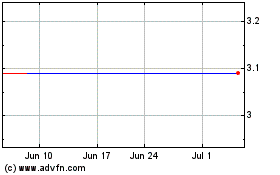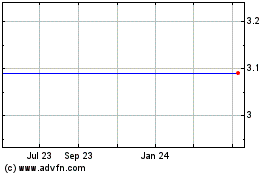Royal Bank of Scotland Records Massive Loss -- 3rd Update
August 05 2016 - 7:58AM
Dow Jones News
By Max Colchester
LONDON-- Royal Bank of Scotland Group PLC will roll out a new
cost-cutting plan after recording first-half net loss of more than
GBP2 billion ($2.26 billion) amid ultralow U.K. interest rates and
uncertainty over Brexit.
RBS's share price slumped more than 5% in morning trading Friday
as investors digested the weaker-than-expected results.
Chief Executive Ross McEwan said his executive team is working
on a new cost-cutting plan that could be presented in the first
quarter of next year. Like several other British banks, RBS warned
of lower returns after the U.K. voted to leave the European
Union.
A day after the Bank of England cut interest rates to a new low,
the outlook for RBS remains murky. Mr. McEwan rued rates that are
now "lower for longer and longer," and said dividends won't be paid
until "2018 at the earliest." The lender said hitting return
targets will now be "more challenging," adding that more specific
guidance will be crafted early next year.
The bank also Friday ditched a plan to list its Williams &
Glyn unit, saying the Bank of England's rate cut meant that the
retail-banking business wouldn't thrive as a stand-alone business.
Earlier this week, RBS received an offer from Banco Santander SA's
U.K. business to buy the unit, according to people familiar with
the offer. The bank must dispose of Williams & Glyn by the end
of 2017 to meet European state aid rules.
The glum outlook echoed views from Lloyds Banking Group PLC and
Barclays PLC, which both warned last week that growth could slow in
the wake of Brexit and lower rates. Lloyds said it was cutting
3,000 extra jobs.
The problems are deeper at RBS. The 73%-government-owned bank's
bottom line was hit by a GBP1.32 billion provision to cover
litigation-and-conduct costs, including an undisclosed amount to
settle a lawsuit brought by shareholders who allege that RBS didn't
disclose its financial health ahead of an emergency capital raising
in 2008.
RBS is halfway through a five-year restructuring plan that
involves a global retreat and expected to feel the most severe
impact of Brexit pushed for a second independence referendumpaying
off billions of dollars of fines. But the effort to clean up past
missteps is proving more expensive and long-winded than analysts
expected. British taxpayers are unlikely to get back a large chunk
of the GBP45.5 billion they pumped into the lender during the
crisis, bankers say. RBS shares have dropped 46% over the past year
to GBP1.84, well below the GBP5 average price the government paid
in 2008.
Brexit isn't helping. The bank has in recent years refocused on
the U.K. and Ireland--two economies expected to feel the most
severe impact of Brexit. It also may move its headquarters if
Scotland were to leave the U.K., analysts say, with Scotland's
leaders having pushed for a second independence referendum.
The lender recorded a net loss of GBP2.05 billion in the first
half of the year, compared with a loss of GBP179 million a year
earlier, creeping toward its ninth successive annual loss. Revenue
fell 17% to GBP6.1 billion. Gary Greenwood, an analyst at Shore
Capital, said the results were "worse than expected."
RBS also took a GBP450 million charge for mis-selling
payment-protection insurance products. Restructuring charges
totaled GBP630 million in the half. Adjusted operating profit,
which strips out provisions, restructuring costs and other negative
items, was GBP2 billion. Income at RBS's corporate and retail units
remained stable compared with last year and should hold up in the
coming year, the bank said.
Write to Max Colchester at max.colchester@wsj.com
(END) Dow Jones Newswires
August 05, 2016 07:43 ET (11:43 GMT)
Copyright (c) 2016 Dow Jones & Company, Inc.
Royal Bank of Scotland (NYSE:RBS)
Historical Stock Chart
From Mar 2024 to Apr 2024

Royal Bank of Scotland (NYSE:RBS)
Historical Stock Chart
From Apr 2023 to Apr 2024
